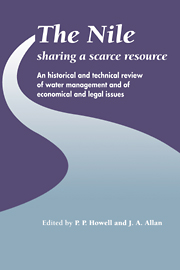 The Nile: Sharing a Scarce Resource
The Nile: Sharing a Scarce Resource Book contents
- Frontmatter
- Contents
- Preface
- List of Contributors
- Orthography
- Units and Conversion Factors
- Introduction
- I Environmental history of the Nile and its management
- II Nile management and factors affecting future management
- III Future utilisation of Nile waters
- 8 Future irrigation planning in Egypt
- 9 Future water development planning in the Sudan
- 10 Irrigation and hydro-power potential. Water needs in Uganda, an overview
- 11 The integrated development of Nile waters
- 12 The control of the swamps of the southern Sudan: Drainage schemes, local effects and environmental constraints on remedial development
- 13 Water balance of the Bahr el Ghazal swamps
- IV Economic, international and legal issues
- Index
9 - Future water development planning in the Sudan
Published online by Cambridge University Press: 05 February 2012
- Frontmatter
- Contents
- Preface
- List of Contributors
- Orthography
- Units and Conversion Factors
- Introduction
- I Environmental history of the Nile and its management
- II Nile management and factors affecting future management
- III Future utilisation of Nile waters
- 8 Future irrigation planning in Egypt
- 9 Future water development planning in the Sudan
- 10 Irrigation and hydro-power potential. Water needs in Uganda, an overview
- 11 The integrated development of Nile waters
- 12 The control of the swamps of the southern Sudan: Drainage schemes, local effects and environmental constraints on remedial development
- 13 Water balance of the Bahr el Ghazal swamps
- IV Economic, international and legal issues
- Index
Summary
Introduction
The flows of the Nile represent the major water resource for the Sudan. Indeed their importance can be best summed up in the ancient Latin dictum “aut Nilus, aut nihil”. At present some 17 km3 out of a total entitlement of 20.55 km3 are allocated to irrigation, storage and hydro-electric projects. Future demands will far exceed the availability of supply and will act as a severe constraint to development in the Sudan. This situation calls for coordinated planning and conservation measures to increase the yield of the Nile and geographical development that makes best use of the available resource.
The development of the waters of the Nile, which is the principal surface water resource of the Sudan, has been the major economic activity of that country over the last 70 years. It has involved the construction of four major dams and the implementation of over four million feddans of irrigation. In recent years water resource development has been the subject of a number of planning and feasibility studies, culminating in the Master Plan presented in the Nile Waters Study of 1979.
The purpose of this chapter is to review the current status of water resources planning and in particular to focus on the growing imbalance between future demands for water and the availability of supplies. Figures quoted are mainly from the Nile Waters Study which outlines the main development options.
- Type
- Chapter
- Information
- The Nile: Sharing a Scarce ResourceA Historical and Technical Review of Water Management and of Economical and Legal Issues, pp. 205 - 216Publisher: Cambridge University PressPrint publication year: 1994
- 5
- Cited by
